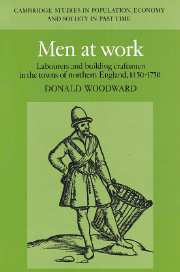Book contents
- Frontmatter
- Contents
- List of tables
- List of appendices
- Preface
- List of abbreviation
- 1 Introduction
- 2 Building craftsmen at work
- 3 The life-cycle of building craftsmen
- 4 Labourers
- 5 Conditions of work for labourers and building craftsmen
- 6 Wage rates in the northern towns
- 7 Towards an understanding of living standards
- Appendices
- Bibliography
- Index
- Cambridge Studies in Population, Economy and Society in Past Time
3 - The life-cycle of building craftsmen
Published online by Cambridge University Press: 15 October 2009
- Frontmatter
- Contents
- List of tables
- List of appendices
- Preface
- List of abbreviation
- 1 Introduction
- 2 Building craftsmen at work
- 3 The life-cycle of building craftsmen
- 4 Labourers
- 5 Conditions of work for labourers and building craftsmen
- 6 Wage rates in the northern towns
- 7 Towards an understanding of living standards
- Appendices
- Bibliography
- Index
- Cambridge Studies in Population, Economy and Society in Past Time
Summary
The apprentice
Apprenticeship was a valued institution in early-modern England. It provided training, chiefly in the manual arts and crafts, and, as contemporary observers were quick to point out, ensured that large numbers of young people were closely controlled during the years before they had acquired sufficient discretion and wisdom to govern themselves and establish their own households. Apprenticeship also regulated the flow of potential master craftsmen, thus avoiding an unacceptably high level of overstocking in the skilled labour market. Finally, it has been argued that apprenticeship provided master craftsmen with a plentiful supply of cheap labour.
Only boys were apprenticed to building craftsmen in the northern towns. No reference has been discovered to the apprenticeship of girls, although some women did participate in the building process: the ability of some women to step into their dead men's shoes suggests that they had received some informal training. Young men were recruited into the building crafts both from within the various towns and from the surrounding countryside. The place of origin is known of 127 of the 286 young men apprenticed to York bricklayers between 1654 and 1752: 61 or 48 per cent were drawn from the city. At Newcastle about a third of the apprentice joiners was home-grown in the later seventeenth century, although internal recruitment became more important in the early decades of the eighteenth century (see table 3.1).
- Type
- Chapter
- Information
- Men at WorkLabourers and Building Craftsmen in the Towns of Northern England, 1450–1750, pp. 53 - 92Publisher: Cambridge University PressPrint publication year: 1995



